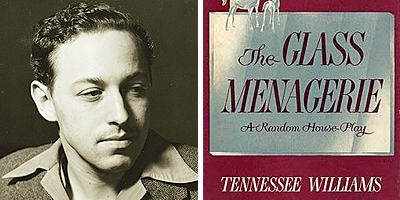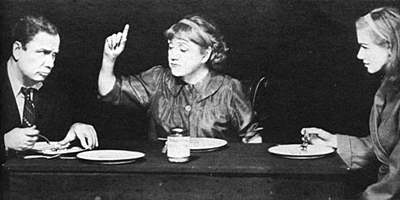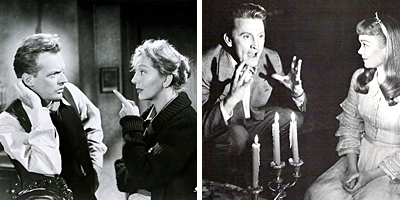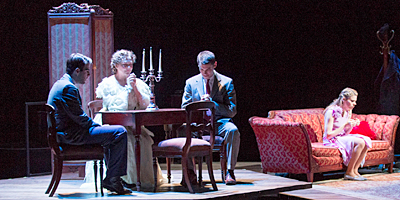Take a Trip Through the Memory of Tennessee Williams and the All-American Classic The Glass Menagerie
You know Tennessee Williams: the Mississippi-born writer whose father didn’t approve of him being an author; the ambling dreamer who went to three different colleges (gaining the nickname Tennessee at the University of Iowa); the renowned playwright who mirrored his family in the characters of his plays, perhaps most prominently in his early masterpiece The Glass Menagerie, which is back on Broadway.

Family Affair
The Glass Menagerie went through several iterations before its Broadway debut. In 1941, Williams, then 30, wrote the short story "Portrait of a Girl in Glass," which focused on Laura Wingfield, a cripplingly shy young girl with a nagging (though unnamed) mother. He abandoned it to write "Daughter of the American Revolution: A Dramatic Portrait of An American Mother (A Comedy)." Therein, the strong, genteel Amanda Wingfield—based on Williams’ mother Edwina—was born.
In the summer of 1943, Williams retooled the story into a screenplay titled The Gentleman Caller, which was rejected by MGM Studios, where he had worked. He redrafted "Portrait" and "Caller" into The Glass Menagerie, which was also rejected; in 1944, he adapted it for the stage. This “memory play” tells the story of faded Southern belle Amanda Wingfield, who shares a small apartment with her creatively frustrated son, Tom, and her fragile daughter, Laura. Amanda insists that Tom bring home a "gentlemen caller" for Laura, whose lack of social confidence contrasts sharply with Amanda's fantasies.
The parallels between Glass and Williams’ real-life family were intentional: The young writer (whose first name is Thomas) was much like free-minded, guilt-ridden Tom; his older sister, Rose (who eventually had a frontal lobotomy), paralleled the afflicted Laura. Williams’ father left the family, as did the Wingfield patriarch; their St. Louis apartment inspired the Wingfield flat. As director Elia Kazan noted of Williams, “Everything in his life is in his plays, and everything in his plays is in his life.”

Menagerie Takes the Stage
The Glass Menagerie debuted in Chicago in December 1944. Though sparsely attended in its first performances, the play exploded in popularity thanks to good reviews, and tranferred to Broadway's Playhouse Theatre on March 31, 1945. The production was directed by Eddie Dowling (who played Tom) and Margo Jones, and it ran for a hefty 563 performances, establishing Williams as a major new voice in American theater.
As Amanda Wingfield, recovering alcoholic Laurette Taylor reprised the role she originated in Chicago for the entire Broadway run, delivering a lauded comeback turn of which Williams later wrote, “It is our immeasurable loss that [her] performances were not preserved on the modern screen.” Julie Haydon played Laura, with stage veteran Anthony Ross as the Gentleman Caller. Although the Tony Awards did not exist until 1947, the play was honored with the New York Drama Critics’ Circle Award two weeks after opening.
The humor, pathos and humanity of Williams classics such as A Streetcar Named Desire, Cat on a Hot Tin Roof and The Rose Tattoo were already evident in The Glass Menagerie. “It really is easy to get lost in [the play] and in his descriptive capacity,” 2013 revival star Zachary Quinto told Broadway.com. “His ability to meld the poetry with the heart of what he’s trying to capture is so profound. How can you not love this play?”

A Messy Movie
Though Hollywood had turned away Gentleman Caller, it welcomed The Glass Menagerie. A popular myth suggests that MGM asked Williams for the rights to the play, but he rejected them. Warner Bros. scooped them up and in 1950 produced a film that Williams biographer Sam Staggs describes as “a commercial failure and an artistic turkey.”
When Williams pitched Gentleman Caller in the early ‘40s, he envisioned Ethel Barrymore as Amanda and Judy Garland as Laura. Helmed by Irving Rapper (who directed Bette Davis in Now Voyager and had some experience with pushy mother figures), the roles went to the miscast British actress Gertrude Lawrence as Amanda, with Jane Wyman as Laura, Arthur Kennedy as Tom and Kirk Douglas as the Gentleman Caller. Rapper later acknowledged that Lawrence’s screen test was better than her performance.
Most insultingly to Williams, the play’s ending was revised for the movie, wherein Laura expects a second gentleman caller, suggesting a happy ending. “They managed to botch it all up,” said an appalled Williams, who delivered halfhearted corrections to the script by Peter Berneis. “It was a mess.” Made-for-TV versions were aired in 1966 (with Shirley Booth) and 1973 (Katharine Hepburn), and in 1987, Paul Newman helmed a film starring his wife Joanne Woodward as Amanda, Karen Allen as Laura, John Malkovich (!) as Tom and James Naughton as the Gentleman Caller.

Never-Empty Glass
Given the juicy nature of the four roles, The Glass Menagerie is frequently revived, including six subsequent Broadway productions. A host of stars have played Amanda (Maureen Stapleton, Jessica Tandy, Julie Harris, Jessica Lange), Tom (Rip Torn, Zeljko Ivanek, Christian Slater), Laura (Piper Laurie, Amanda Plummer, Pamela Payton-Wright, Calista Flockhart, Sarah Paulson) and the Gentleman Caller (John Heard, Josh Lucas). A much-lauded 2010 off-Broadway revival starred Judith Ivey, who emphasized the humor in the play.
Tennessee native Cherry Jones had never pined to play Amanda, feeling too close to the world of the play, but she changed her mind after director John Tiffany convinced her to read it aloud. (The Scottish-born Tiffany, a Tony winner for Once, has said that Glass Menagerie is his favorite play.) The pair headed to the American Repertory Theatre in Cambridge, MA, in February 2013 for a production co-starring wo-time Tony nominee Celia Keenan-Bolger as Laura, screen star Quinto as Tom and Brian J. Smith as the Gentleman Caller.
With a set design by Tony winner Bob Crowley featured floating platforms, which Tiffany called “a liquid abyss,” Smith told Broadway.com, “Our version is sort of what Tennessee asked for at the very beginning, which was to get rid of the walls and the claustrophobic trappings of a realistic play. [We] open it up and put some magic into the theater and get rid of anything that doesn’t tell the story in a poetic way.” The production earned rave reviews and was fast-tracked to Broadway, where it will open on September 26 at the Booth Theatre.
“Obviously it feels great," Jones told Broadway.com of the Main Stem revival, "but it's not only [being able to revive] an American masterpiece. It’s coming with the dual brilliance of Tennessee Williams and John Tiffany. I wish Tennessee had known Tiffany because they both have that quality of lifting, heightening lyricism, depth and beauty in telling heartbreakingly devastating human tales."
